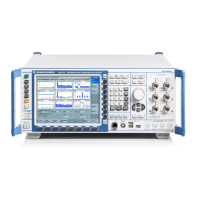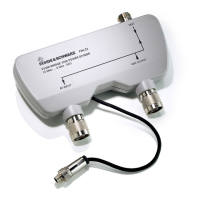System Overview
R&S
®
CMW500
77User Manual 1173.9463.02 ─ 02
The constellation diagrams depend on the modulation type; for details refer to the
description of the individual firmware applications. The diagrams are normalized such
that the average distance of all points from the origin is 1.
Constellation diagrams give a graphical representation of the signal quality and can help
to reveal typical modulation errors causing signal distortions, as shown in the table below.
In practice, the received signal will show a combination of the modulation errors listed.
For details about the I/Q imbalance and the I/Q origin offset refer to Modulation Accu-
racy.
Modulation error Description / cause Effect in the constellation
diagram
I/Q imbalance Caused by different gains of the I and Q components One of the components is
expanded, the other com-
pressed
I/Q origin offset Caused by an interfering signal at the RF carrier fre-
quency
All constellation points are shif-
ted by the same vector
Interferer Non-coherent single-frequency spurious signal in the
frequency band, superimposed on the modulated sig-
nal
Rotating pointer superimposed
on each constellation point,
causes circular constellation
points
Gaussian noise Uncorrelated interfering signals Fuzzy constellation points
Phase error Phase shift between I and Q components different
from 90 deg
Non-orthogonal I and Q com-
ponents
Phase noise Uncorrelated phase error Rotationally spreading constel-
lation points
Amplitude com-
pression
Large amplitudes below the nominal value, caused by
non-linear components in the transmission path
Corner points move towards
the center
Unused detected
subcarriers (in
OFDMA systems)
An unused/inactive subcarrier is measured, most
likely due to a mismatch between the TX measure-
ment settings and the measured signal
Unexpected constellation
close to the origin (zero signal
power)
4.3.7.6 Multi Evaluation Measurements
In a multi evaluation measurement, the R&S CMW500 acquires a wide range of mea-
surement results at once.
For example, the GSM multi evaluation measurement provides the most important GSM
mobile transmitter test results described in specification 3GPP TS 51.010:
●
The transmitter output power versus time
●
Results that describe the modulation accuracy: Error vector magnitude (EVM), phase
error, frequency error for each symbol, normalized I/Q vector at and between the
decision points (I/Q constellation, vector and phase diagrams)
●
Results that describe the output RF spectrum: adjacent channel power (ACP) due to
modulation and due to switching, ACP versus time
The WiMAX multi evaluation measurement assesses the modulation accuracy, fre-
quency error, power, crest factor, and spectral flatness in the measured burst as descri-
Measurements

